Page 221 of 350
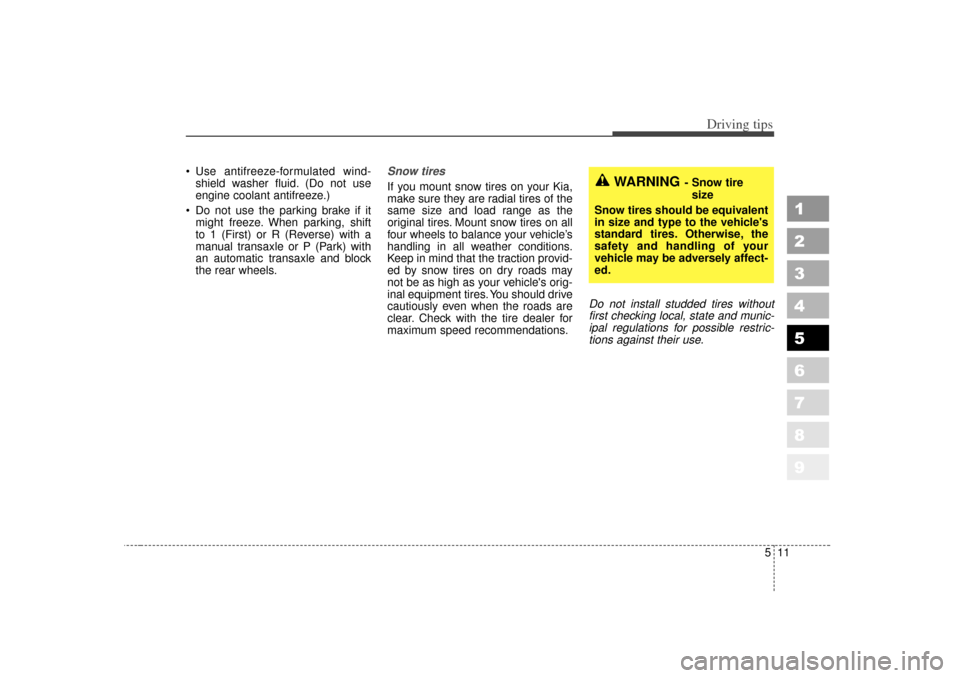
511
Driving tips
1
2
3
4
5
6
7
8
9
Use antifreeze-formulated wind-shield washer fluid. (Do not use
engine coolant antifreeze.)
Do not use the parking brake if it might freeze. When parking, shift
to 1 (First) or R (Reverse) with a
manual transaxle or P (Park) with
an automatic transaxle and block
the rear wheels.
Snow tires If you mount snow tires on your Kia,
make sure they are radial tires of the
same size and load range as the
original tires. Mount snow tires on all
four wheels to balance your vehicle’s
handling in all weather conditions.
Keep in mind that the traction provid-
ed by snow tires on dry roads may
not be as high as your vehicle's orig-
inal equipment tires. You should drive
cautiously even when the roads are
clear. Check with the tire dealer for
maximum speed recommendations.
Do not install studded tires withoutfirst checking local, state and munic-ipal regulations for possible restric-tions against their use.
WARNING
- Snow tire
size
Snow tires should be equivalent
in size and type to the vehicle's
standard tires. Otherwise, the
safety and handling of your
vehicle may be adversely affect-
ed.
Page 222 of 350
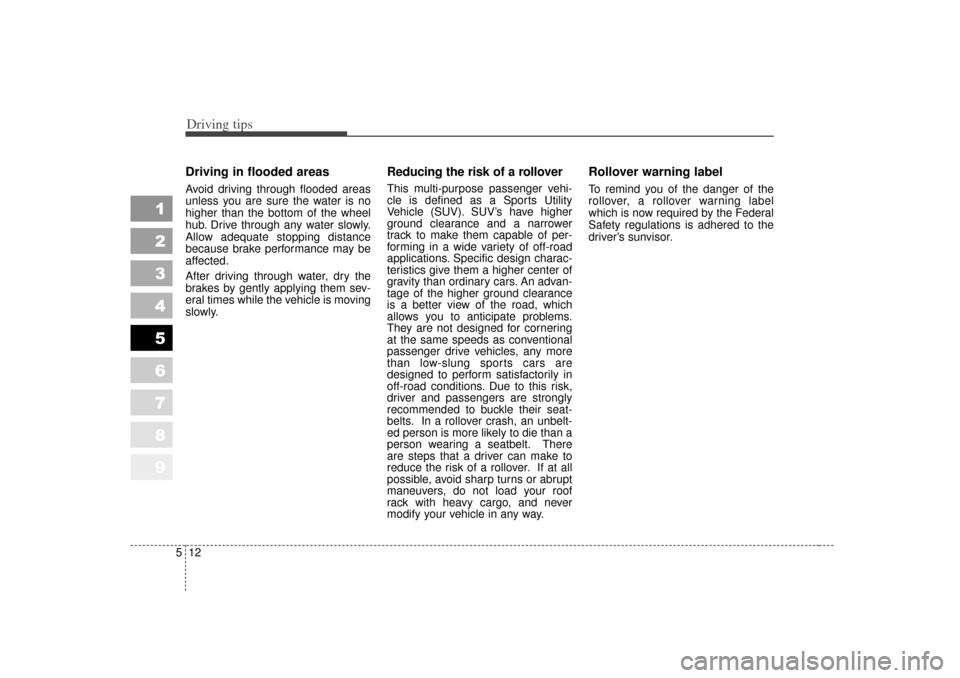
Driving tips12
5
1
2
3
4
5
6
7
8
9
Driving in flooded areas Avoid driving through flooded areas
unless you are sure the water is no
higher than the bottom of the wheel
hub. Drive through any water slowly.
Allow adequate stopping distance
because brake performance may be
affected.
After driving through water, dry the
brakes by gently applying them sev-
eral times while the vehicle is moving
slowly.
Reducing the risk of a rolloverThis multi-purpose passenger vehi-
cle is defined as a Sports Utility
Vehicle (SUV). SUV’s have higher
ground clearance and a narrower
track to make them capable of per-
forming in a wide variety of off-road
applications. Specific design charac-
teristics give them a higher center of
gravity than ordinary cars. An advan-
tage of the higher ground clearance
is a better view of the road, which
allows you to anticipate problems.
They are not designed for cornering
at the same speeds as conventional
passenger drive vehicles, any more
than low-slung sports cars are
designed to perform satisfactorily in
off-road conditions. Due to this risk,
driver and passengers are strongly
recommended to buckle their seat-
belts. In a rollover crash, an unbelt-
ed person is more likely to die than a
person wearing a seatbelt. There
are steps that a driver can make to
reduce the risk of a rollover. If at all
possible, avoid sharp turns or abrupt
maneuvers, do not load your roof
rack with heavy cargo, and never
modify your vehicle in any way.
Rollover warning labelTo remind you of the danger of the
rollover, a rollover warning label
which is now required by the Federal
Safety regulations is adhered to the
driver’s sunvisor.
Page 223 of 350
513
Driving tips
1
2
3
4
5
6
7
8
9
To remind you of the danger of the
rollover, the rollover warning label is
adhered to the driver’s sunvisor. If
you close the driver’s sunvisor, you
can see the rollover warning label
which is located at the side of the air
bag warning label.
WARNING
- Rollover
As with other Sports Utility
Vehicle (SUV), failure to operate
this vehicle correctly may result
in loss of control, an accident or
vehicle rollover.
Specific design characteris- tics (higher ground clearance,
narrower track, etc.) give this
vehicle a higher center of
gravity than ordinary cars.
A SUV is not designed for cor- nering at the same speeds as
conventional vehicles.
Avoid sharp turns or abrupt maneuvers.
In a rollover crash, an unbelt- ed person is significantly
more likely to die than a per-
son wearing a safety belt.
Make sure everyone in the
vehicle is properly buckled up.
1KMN5513
Page 224 of 350
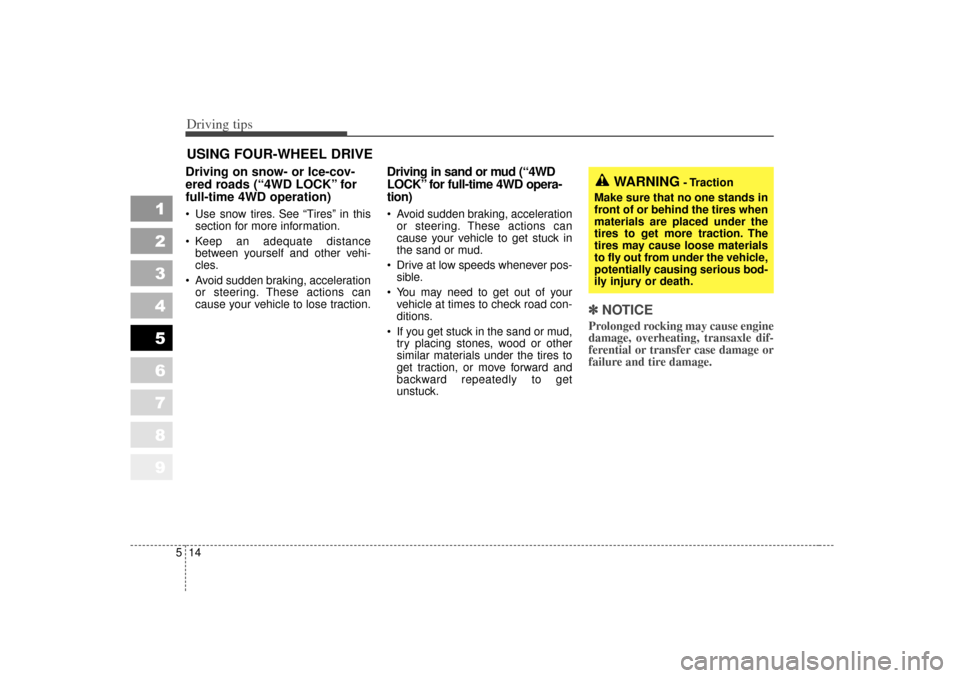
Driving tips14
5
1
2
3
4
5
6
7
8
9
USING FOUR-WHEEL DRIVEDriving on snow- or Ice-cov-
ered roads (“4WD LOCK” for
full-time 4WD operation) Use snow tires. See “Tires” in this
section for more information.
Keep an adequate distance between yourself and other vehi-
cles.
Avoid sudden braking, acceleration or steering. These actions can
cause your vehicle to lose traction.
Driving in sand or mud (“4WD
LOCK” for full-time 4WD opera-
tion) Avoid sudden braking, accelerationor steering. These actions can
cause your vehicle to get stuck in
the sand or mud.
Drive at low speeds whenever pos- sible.
You may need to get out of your vehicle at times to check road con-
ditions.
If you get stuck in the sand or mud, try placing stones, wood or other
similar materials under the tires to
get traction, or move forward and
backward repeatedly to get
unstuck.
✽ ✽
NOTICEProlonged rocking may cause engine
damage, overheating, transaxle dif-
ferential or transfer case damage or
failure and tire damage.
WARNING
- Traction
Make sure that no one stands in
front of or behind the tires when
materials are placed under the
tires to get more traction. The
tires may cause loose materials
to fly out from under the vehicle,
potentially causing serious bod-
ily injury or death.
Page 227 of 350
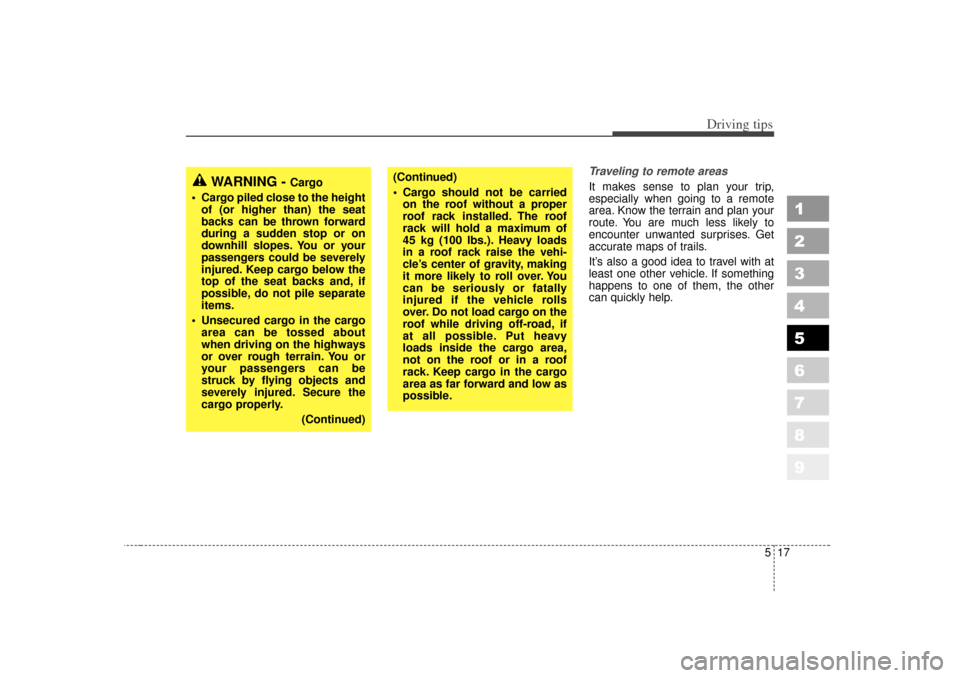
517
Driving tips
1
2
3
4
5
6
7
8
9
Traveling to remote areasIt makes sense to plan your trip,
especially when going to a remote
area. Know the terrain and plan your
route. You are much less likely to
encounter unwanted surprises. Get
accurate maps of trails.
It’s also a good idea to travel with at
least one other vehicle. If something
happens to one of them, the other
can quickly help.
WARNING -
Cargo
Cargo piled close to the height of (or higher than) the seat
backs can be thrown forward
during a sudden stop or on
downhill slopes. You or your
passengers could be severely
injured. Keep cargo below the
top of the seat backs and, if
possible, do not pile separate
items.
Unsecured cargo in the cargo area can be tossed about
when driving on the highways
or over rough terrain. You or
your passengers can be
struck by flying objects and
severely injured. Secure the
cargo properly.
(Continued)
(Continued)
Cargo should not be carriedon the roof without a proper
roof rack installed. The roof
rack will hold a maximum of
45 kg (100 lbs.). Heavy loads
in a roof rack raise the vehi-
cle’s center of gravity, making
it more likely to roll over. You
can be seriously or fatally
injured if the vehicle rolls
over. Do not load cargo on the
roof while driving off-road, if
at all possible. Put heavy
loads inside the cargo area,
not on the roof or in a roof
rack. Keep cargo in the cargo
area as far forward and low as
possible.
Page 228 of 350
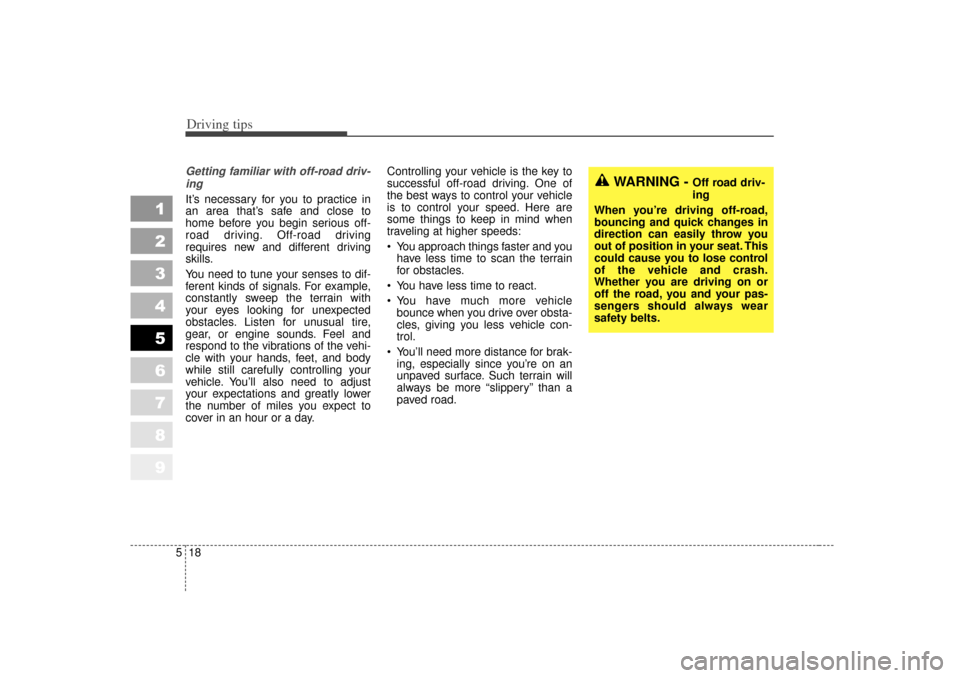
Driving tips18
5
1
2
3
4
5
6
7
8
9
Getting familiar with off-road driv-
ingIt’s necessary for you to practice in
an area that’s safe and close to
home before you begin serious off-
road driving. Off-road driving
requires new and different driving
skills.
You need to tune your senses to dif-
ferent kinds of signals. For example,
constantly sweep the terrain with
your eyes looking for unexpected
obstacles. Listen for unusual tire,
gear, or engine sounds. Feel and
respond to the vibrations of the vehi-
cle with your hands, feet, and body
while still carefully controlling your
vehicle. You’ll also need to adjust
your expectations and greatly lower
the number of miles you expect to
cover in an hour or a day. Controlling your vehicle is the key to
successful off-road driving. One of
the best ways to control your vehicle
is to control your speed. Here are
some things to keep in mind when
traveling at higher speeds:
You approach things faster and you
have less time to scan the terrain
for obstacles.
You have less time to react.
You have much more vehicle bounce when you drive over obsta-
cles, giving you less vehicle con-
trol.
You’ll need more distance for brak- ing, especially since you’re on an
unpaved surface. Such terrain will
always be more “slippery” than a
paved road.
WARNING -
Off road driv-
ing
When you’re driving off-road,
bouncing and quick changes in
direction can easily throw you
out of position in your seat. This
could cause you to lose control
of the vehicle and crash.
Whether you are driving on or
off the road, you and your pas-
sengers should always wear
safety belts.
Page 230 of 350
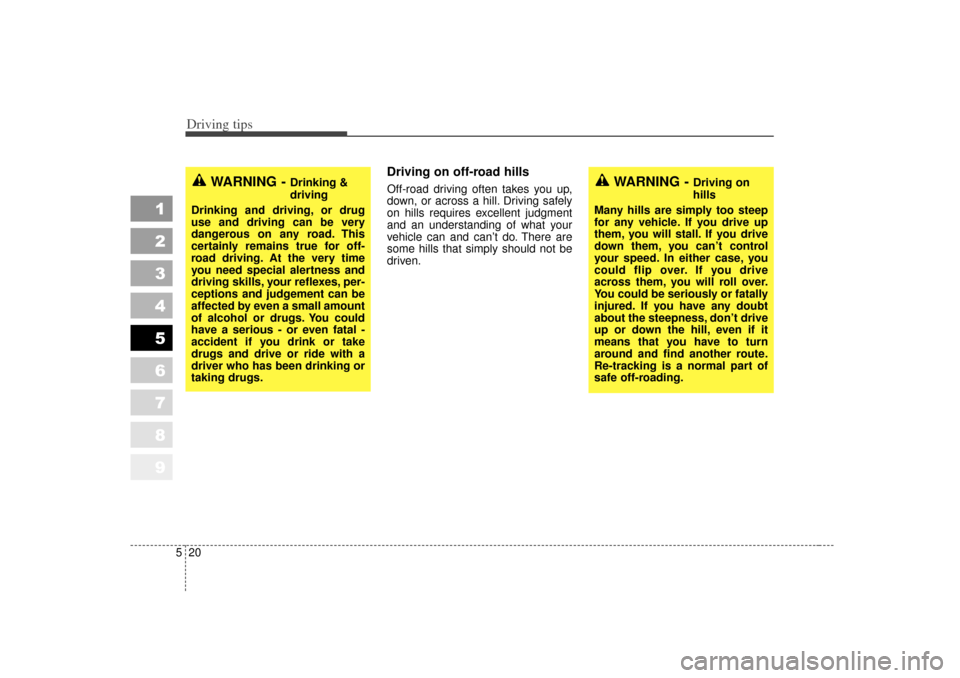
Driving tips20
5
1
2
3
4
5
6
7
8
9
Driving on off-road hillsOff-road driving often takes you up,
down, or across a hill. Driving safely
on hills requires excellent judgment
and an understanding of what your
vehicle can and can’t do. There are
some hills that simply should not be
driven.
WARNING -
Drinking &
driving
Drinking and driving, or drug
use and driving can be very
dangerous on any road. This
certainly remains true for off-
road driving. At the very time
you need special alertness and
driving skills, your reflexes, per-
ceptions and judgement can be
affected by even a small amount
of alcohol or drugs. You could
have a serious - or even fatal -
accident if you drink or take
drugs and drive or ride with a
driver who has been drinking or
taking drugs.
WARNING -
Driving on
hills
Many hills are simply too steep
for any vehicle. If you drive up
them, you will stall. If you drive
down them, you can’t control
your speed. In either case, you
could flip over. If you drive
across them, you will roll over.
You could be seriously or fatally
injured. If you have any doubt
about the steepness, don’t drive
up or down the hill, even if it
means that you have to turn
around and find another route.
Re-tracking is a normal part of
safe off-roading.
Page 232 of 350
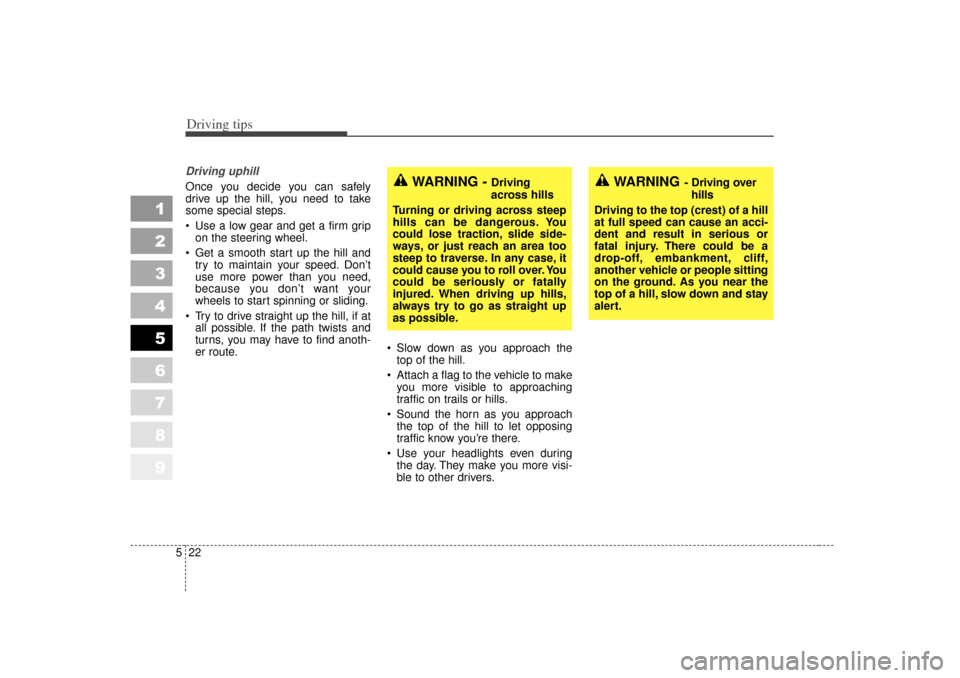
Driving tips22
5
1
2
3
4
5
6
7
8
9
Driving uphillOnce you decide you can safely
drive up the hill, you need to take
some special steps.
Use a low gear and get a firm grip
on the steering wheel.
Get a smooth start up the hill and try to maintain your speed. Don’t
use more power than you need,
because you don’t want your
wheels to start spinning or sliding.
Try to drive straight up the hill, if at all possible. If the path twists and
turns, you may have to find anoth-
er route. Slow down as you approach the
top of the hill.
Attach a flag to the vehicle to make you more visible to approaching
traffic on trails or hills.
Sound the horn as you approach the top of the hill to let opposing
traffic know you’re there.
Use your headlights even during the day. They make you more visi-
ble to other drivers.
WARNING -
Driving
across hills
Turning or driving across steep
hills can be dangerous. You
could lose traction, slide side-
ways, or just reach an area too
steep to traverse. In any case, it
could cause you to roll over. You
could be seriously or fatally
injured. When driving up hills,
always try to go as straight up
as possible.
WARNING
- Driving over hills
Driving to the top (crest) of a hill
at full speed can cause an acci-
dent and result in serious or
fatal injury. There could be a
drop-off, embankment, cliff,
another vehicle or people sitting
on the ground. As you near the
top of a hill, slow down and stay
alert.